Excerpts from Jim Conrad's
Naturalist Newsletter
entry from field notes dated January 19, 2023, taken along steep, one-lane gravel road ascending forested, northeast-facing mountain slope, elevation ±2,380m (7600 ft); bedrock of Cretaceous limestone; on the south side of Pinal de Amoles, Querétaro state, MÉXICO, (N21.134°, W99.629°)
CESTRUM OBLONGIFOLIUM
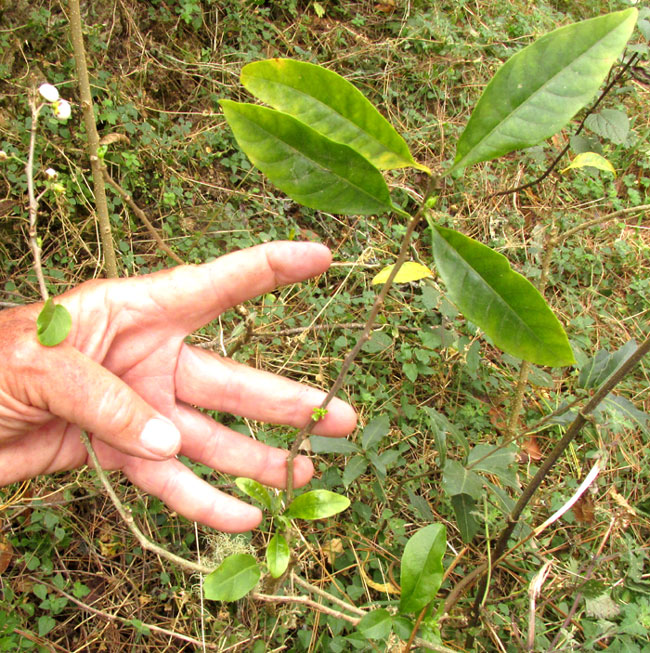
Atop a ridge where clouds must frequently sweep through the forest as cold fog, beside a trail through pine woods, the above slender-stemmed, sprawling, somewhat disorganized-looking woody shrub bore the white fruits visible at the picture's top, left corner, and below.

The white, fleshy fruits were spherical, and subtended by broad sepals and short, thick pedicels.
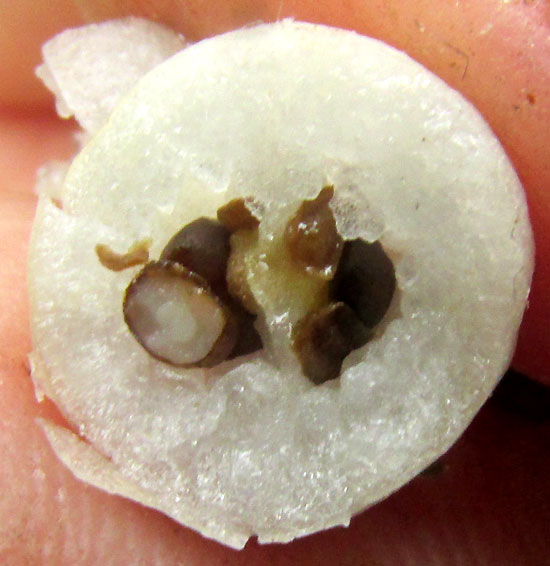
Cutting off a fruit's top half, inside several seeds were revealed residing in two compartments, or locules, separated by a thin, white partition. Thus the fruit technically was a berry, meaning that it was a simple, fleshy fruit containing more than one seed. This white berry divided into two locules put me in the mind of the big Nightshade or Potato/Tomato Family, the Solanaceae. Now we had a good starting point for identifying our plant.
Happily, one branch of our gangly plant bore immature flowers on the verge of opening into what appeared would be yellow blossoms with long, slender corolla tubes, with corolla lobes expanding abruptly at the top -- "salverform" corollas:

Finally, a closer look at a leaf, with its gradually diminishing base, "herring-bone" pattern of venation, and lack of hairs:
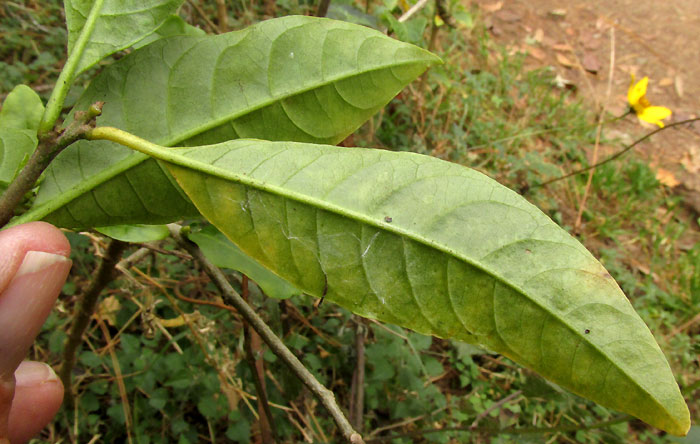
In this part of the world if you have a member of the Nightshade Family that's woody, produces salverform corollas with such slender tubes, and fruits with two locules, you have the genus Cestrum. In English Cestrum species often known as cestrums. Cestrum is a big New World genus with maybe 150-250 species, found mostly in warm-temperate and tropical zones. In our region of upland central Mexico known at the Bajío, about 15 species have been documented.
In our area if you have a Cestrum with hairless leaves, yellow flowers atop very short, thick pedicels, and the calyx bears broad lobes like those beneath our fruits, you have CESTRUM OBLONGIFOLIUM.
Cestrum oblongifolium is endemic just to the central Mexican uplands, from the state of Nuevo León south to Oaxaca, so it bears no English name, or even any commonly used Spanish name just for it. It occurs in various mountain forests at 1200-2500m (3900-8200ft).
Our homely little plant, except for appearing on lists of plants made in specific locations, is hardly represented in the literature. The most famous Cestrum species surely is the fabulously fragrant Lady of the Night, which often sweetened our nights in the Yucatan. The online Atlas de las Plantas de la Medicina Tradicional Mexicana refers to the fragrance of that species as functioning as a sedative -- which I can believe -- as well as against epileptic seizures. Flowers of our Cestrum oblongifolium, however, are described as odorless.
entry from field notes dated May 5, 2023, taken along paved road to El Doctor, about 2km above intersection with Hwy 120 running east to San Joaquín; juniper, oak and pine forest on limestone bedrock; elevation ±2500m (8200 ft); Eastern Sierra Madre mountains of east-central Querétaro state, MÉXICO, (N20.88°, W99.62°)
FLOWERING CESTRUM OBLONGIFOLIUM
A little over four months later another Cestrum oblongifolium turns up, this time flowering:
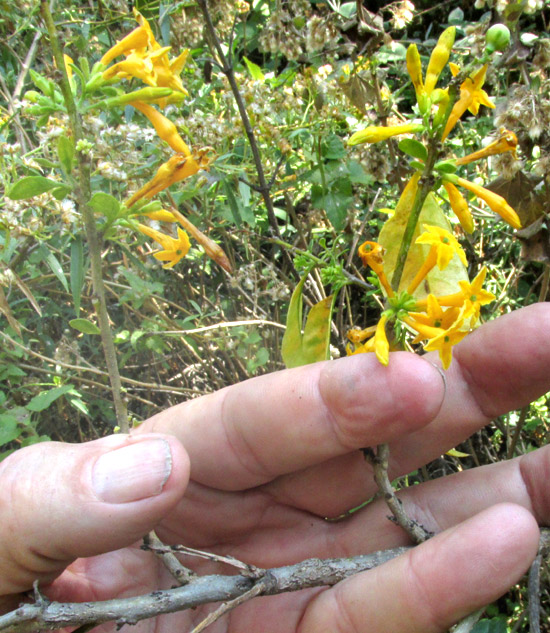
The flowers gather in compacted cymes, cymes being clusters in which a single flower develops first, then other blossoms arise around it on side stems.

Above, a green stigma rises to the corolla's opening, with pale brown anthers right below it
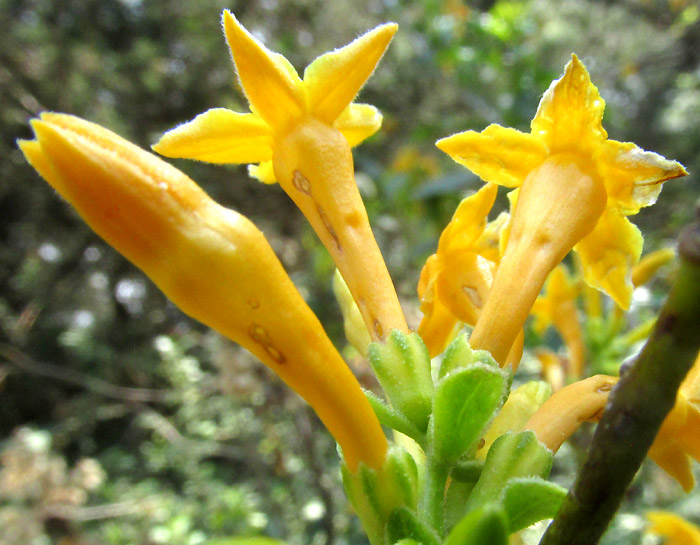
A side view shows that the corolla tubes enlarge immediately below the lobes, and before lobes spread out they're held straight up. Note that the sepals are broadly rounded at their tips. For identification purposes that's important, because sepals of another very similar looking Cestrum, Cestrum aurantiacum, produce short, sharp points, or "mucros," at their tips.
This time the bush was less sprawling and enmeshed among herbage, so a better idea of the plant's general organization was achieved:
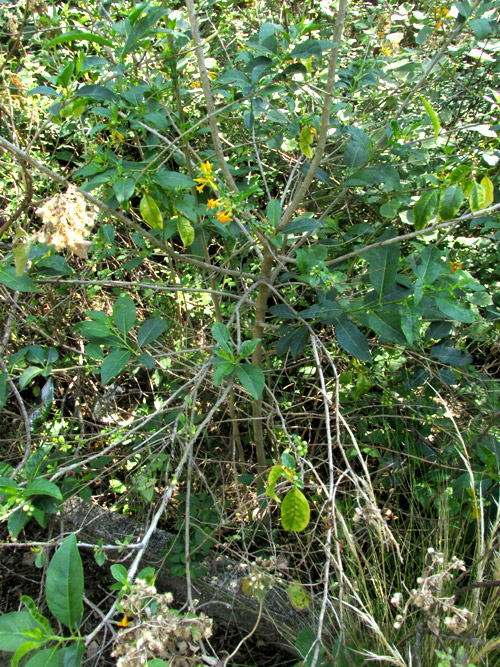
The side branches rambled off through the surrounding bushes almost vine-like, though not twining.